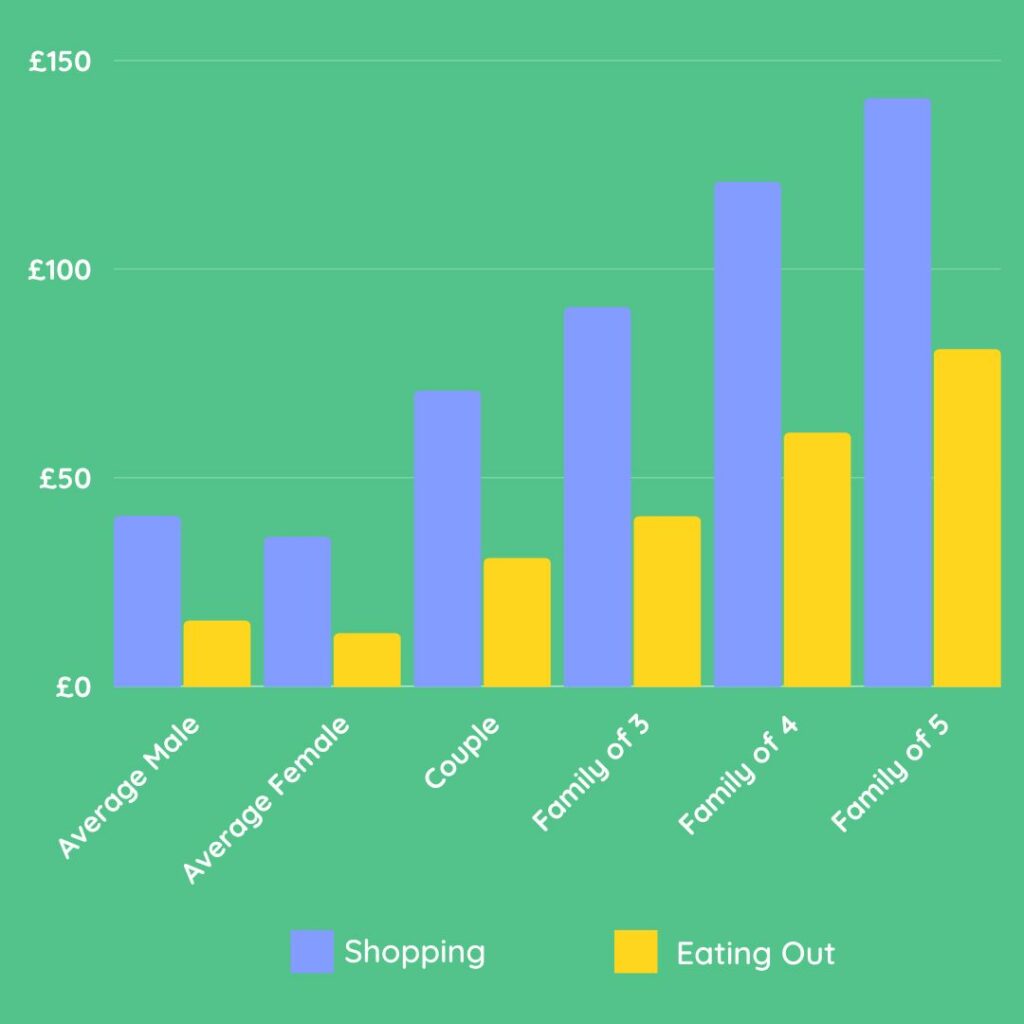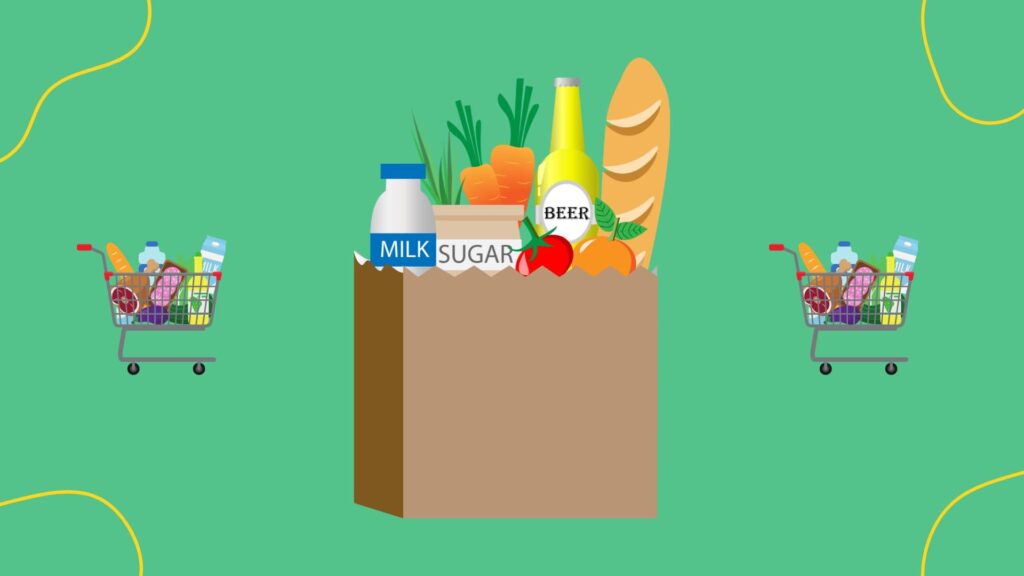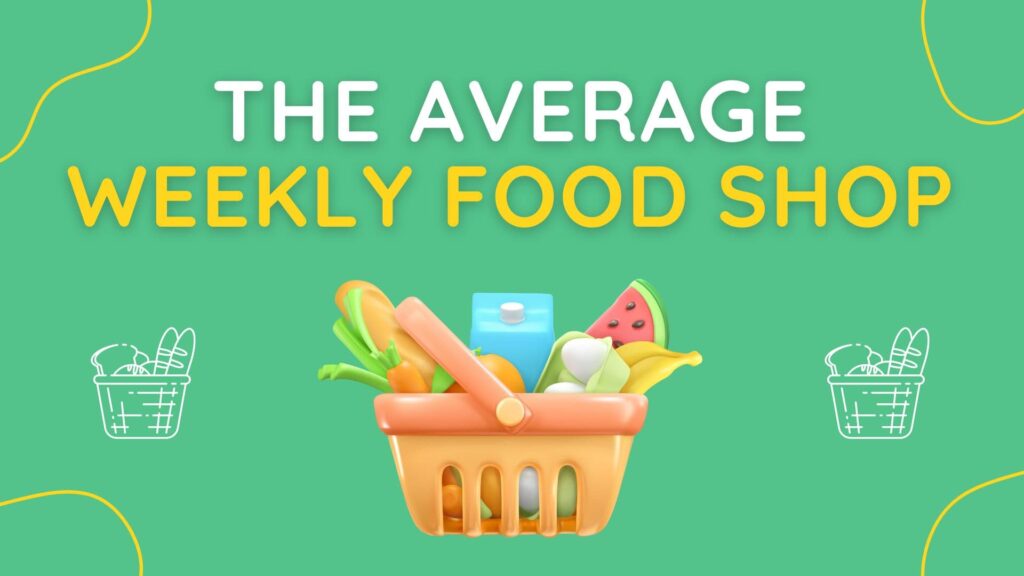
Sammie Ellard-King
I’m Sammie, a money expert and business owner passionate about helping you take control of your wallet. My mission with Up the Gains is to create a safe space to help improve your finances, cut your costs and make you feel good while doing it.

Quickfire Roundup:
Food prices have been rising due to inflation, and currently, the average 1-person household spends around £40.70 per week on their food shop.
If you increase this to a family of four, the average spend goes up to £107.50 a week.
This amount is £2,116.40 per year for a single person and £5,590 per year for a family of four.
Times are tough. Not only have our energy bills been on the rise, but so has our food.
According to new data from the office of national statistics (ONS) and the houses of parliament, Uk households have seen food prices rising consistently for the past 17 months.
In fact, the average grocery bill in the UK is 17% more expensive than it was 12 months ago, and there is a 93% increase in the usage of food banks across the country.
If you’re thinking about how you could possibly cut back spending or are wondering how much does the average person spend a week on a food shop, then you’ve come to the right place.
Table of Contents
How much does the average person spend a week on a food shop?
As we write this, inflation figures have been rampant, increasing costs spend on food all over the place.
With the 17% rise in overall monthly food costs, you can expect to pay £600-700 more a year on your grocery bills.
Not great, but recent figures have also shown inflation to have finally peaked, so hopefully, we will see some price decreases or at least some stability.
With prices changing almost daily at the moment, it’s challenging to pinpoint exact numbers, so I’ve arranged the average grocery spending based on the time of writing and some past data.
Key Stats
- According to the UK government, the average household of 2.4 people spends 10.8% on food and non-alcoholic drinks.
- The average person spends £40.80 a week on their grocery bills
- The average person spends £15.80 eating out, including quick-serve dining and cafes.
One person
| Time | Food Shop | Eating Out |
|---|---|---|
| Weekly | £40.80 | £15.80 |
| Bi-Weekly | £81.60 | £31.60 |
| Monthly | £163.20 | £63.20 |
| Quarterly | £489.60 | £189.60 |
| Yearly | £1,958.40 | £758.40 |
Based on 1 persons average food shop and eating out spend split over 1 year.
Looking at the data if we work out the average UK wage, which is currently £38,131 a year or £2,440 a month after tax vs the total monthly food spend of £226.40 (£163.20 + £63.20) then the average single person is spending 9.28% of their monthly disposable income on food and non-alcoholic beverages.
This is 1.6% below the average household spend as minors will increase the total food spend.
These percentages will vary massively depending on your family size and what a single person consumes vs a family of two adults and two children is hugely different.
The current average family size is 2.4 people and we’ve looked into the average spending from a single person right up to a family of 5.
Weekly food spend by family number

Source: Nimblefins with adjusted inflation numbers added
How does income affect what we eat?
Families in the UK with a higher disposable income tend to eat healthier and spend more money on things like fresh fruit, vegetables and organic meats, fish and produce.
Lower-income families tend to have a less nutritious diet and buy more frozen or pre-made food products like microwave meals or processed meats.
The main factor behind this is the cost, as organic and better-quality food products will always be more expensive.
The average UK salary is around £32,000 right now and this increases in the capital with the London average salary at around £37,000.
Essentially for you to live comfortably you need to earn at least the median wage right now and if you have a household with dependants you should look to double that number.
How is the cost of living crisis affecting the cost of food?
Several things have affected prices, including the Covid-19 crisis, where governments printed a lot of money to help stimulate the economy, Brexit and animal feed prices.
Then the Russia / Ukraine war has also helped push energy and commodity prices up. Albeit now the energy prices are starting to come down which will ease the burden on households.
This means supply lines and the cost to produce food are higher, which, unfortunately, is paid for by the consumers.
Disposable incomes have remained the same as wages stagnate, meaning the average UK family is worse off as their spending on food is higher.
Figures for the increase in household food items as shown in a recent report by ONS in November 2022.
- Low-fat milk: 45.2%
- Olive Oil: 44.6%
- Sugar: 40.9%
- Whole milk: 37.2%
- Cheese and curd: 35.2%
- Edible offal: 31.6%
- Frozen veg: 29%
- Eggs: 28.8%
- Flours & other cereal: 27.9%
- Butter: 27.1%
There is clearly high food inflation on essential items, and these cost increases are wreaking havoc as supermarkets scramble to remain competitive.
It does however depend on where you live with the living costs in London a lot higher than rural areas or Northern cities.
Equally the average mortgage cost in the UK is now on the rise with interest rates reaching a 15 year high. This means unfortunately we’re being squeezed in lots of different ways and it’s not just food costs that we’re now having to struggle with.
Next up, we’re going to look into how you can keep your monthly food costs down by being creative about where and how you shop.
How can I reduce my food costs?

Buying as you go and shopping in Sainsbury’s Local or Tesco Express is one of the fastest ways to increase the price of a weekly food shop.
Equally full shops in places like Waitrose and Marks and Spencer will soon add up.
We all know Aldi and Lidl are cheaper options, and in fact, the quality of the products on everyday items like fresh vegetables, fresh fruit and meat is pretty decent.
According to a recent study by Which, Aldi is shown as 15% cheaper than Waitrose and 10% cheaper than Asda on everyday household items.
Here are some tips for reducing your food bills:
- Meal plan in advance
- Batch cook or use meal boxes
- Make use of the best cashback apps
- Supermarket loyalty schemes
- Avoid pre-prepared veg and fruit
- Freeze items that may go out of date
- Host meat-free Mondays
- Make packed lunches for work
- Look for the supermarkets’ own brands
- Cut back on wastage
- Reduce consumption of alcoholic drinks
What is the average cost of eating out vs eating in?

The average meal cost in the UK for food and drink at a local restaurant is £12-20 for one person, increasing to £15-25 per person in London.
If you’re going somewhere fancier, this can increase up to £50 per person.
This is in stark contrast to eating in, with the average meal costing somewhere between £3-7 per person, depending on what you eat.
Equally the cost of food in London will be higher than most other places in the UK.
How much should I spend on my grocery shop?
If you factor in the numbers, people who earn £60k or more spend up to 30% more a month on food.
This is down to eating out in restaurants and grabbing quick-serve lunches during the working day instead of taking in packed lunches.
Looking at the data above, spending between 9-11% of your wage on your monthly food shop is what you should aim for.
There will obviously be fluctuations depending on the time of year, as we all know that we eat much more during Christmas.
Now, these figures above do not include things like pet food which would be an added expense. For example, I feed my dog raw food and this cost adds up to another £40 a month.
How can budgeting help your money go further?
Being smart with your money can help you save money on your weekly food shop but also help make your money go further in all walks of life.
If you struggle to get to the end of the month and are living paycheck to paycheck, then creating a comprehensive budget will help.
By identifying what you have coming in each month vs what’s going out, you will start to identify where you are overspending.
Tracking things like your average monthly food budget and cutting back on your weekly spend on things like morning coffees or expensive lunches is a great place to start.
Let the latest technology help get you there with the best money savings apps.
You might look at it and say that it’s only £30 worth of savings, but over a year, that’s over £360, which essentially pays for Christmas or means you can start saving for bigger things like a house deposit.
The average savings by age in the UK is something which has been highlighted recently with over 11.4 million people now with under £100 saved.
Check out our monthly budgeting spreadsheet which can help you with your household budget and also things like debt repayments, investing pots and more.
 Sale!
Sale! Ultimate Financial Planner
£25.00 Original price was: £25.00.£17.00Current price is: £17.00.
FAQs
How much should 1 person spend on food?
One person’s average monthly food spending should be £120-160. This will vary depending on your income and the time of year. We naturally eat more during the winter months and, of course, during Christmas.
How much does it cost to feed 2 adults for a month?
The average monthly food budget for 2 adults is £200-£250. This doesn’t include items like toiletries, alcohol and clothes. If you’re looking to buy more organic food items, this could increase to £400 a month.
Final Thoughts
So, we’ve covered how much you should be spending on your grocery shopping and your average monthly food budget, depending on your family size.
It’s important to note that the average food cost for everyday items will fluctuate a fair bit over the next few months due to uncertainty with the economy and inflation.
Share this article with friends
Disclaimer: Content on this page is for informational purposes and does not constitute financial advice. Always do your own research before making a financially related decision.



